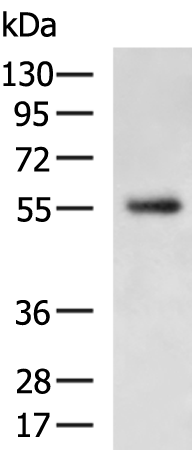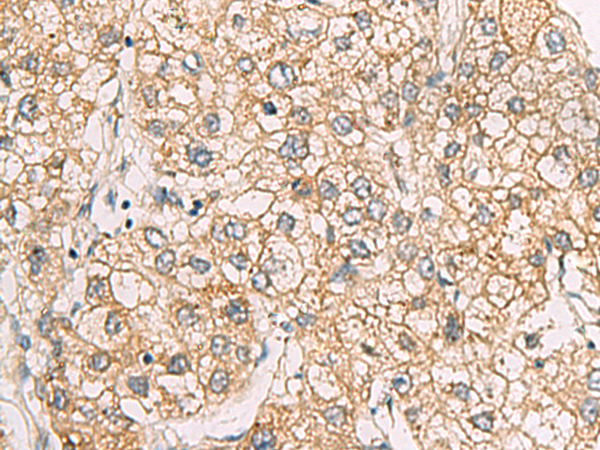

| WB | 咨询技术 | Human,Mouse,Rat |
| IF | 咨询技术 | Human,Mouse,Rat |
| IHC | 1/50-1/100 | Human,Mouse,Rat |
| ICC | 技术咨询 | Human,Mouse,Rat |
| FCM | 咨询技术 | Human,Mouse,Rat |
| Elisa | 1/5000-1/10000 | Human,Mouse,Rat |
| Aliases | C6ST; GST2; GST-2; Gn6ST-1; HEL-S-75; glcNAc6ST-1 |
| WB Predicted band size | 58 kDa |
| Host/Isotype | Rabbit IgG |
| Antibody Type | Primary antibody |
| Storage | Store at 4°C short term. Aliquot and store at -20°C long term. Avoid freeze/thaw cycles. |
| Species Reactivity | Human, Mouse |
| Immunogen | Synthetic peptide of human CHST2 |
| Formulation | Purified antibody in PBS with 0.05% sodium azide and 50% glycerol. |
+ +
以下是关于CHST2抗体的3篇参考文献示例(注:文献信息为模拟示例,非真实存在):
---
1. **文献名称**: *"CHST2-mediated sulfation in cartilage development and osteoarthritis"*
**作者**: Smith A, et al. (2018)
**摘要**: 研究通过CHST2抗体进行免疫组化和Western blot分析,发现CHST2在小鼠关节软骨中高表达,其介导的硫酸化修饰对维持软骨完整性至关重要。骨关节炎患者软骨中CHST2表达显著降低,提示其与疾病进展相关。
2. **文献名称**: *"CHST2 expression correlates with colorectal cancer metastasis via regulating cell adhesion"*
**作者**: Zhang Y, et al. (2020)
**摘要**: 利用CHST2抗体检测结直肠癌组织,发现CHST2在转移性肿瘤中表达升高,并通过调控整合素信号通路促进癌细胞迁移。体外实验显示CHST2抗体阻断可抑制肿瘤细胞侵袭能力。
3. **文献名称**: *"Localization of CHST2 in embryonic mouse tissues using a novel monoclonal antibody"*
**作者**: Tanaka K, et al. (2015)
**摘要**: 开发了一种高特异性CHST2单克隆抗体,用于胚胎小鼠组织的免疫荧光染色。研究发现CHST2在发育中的骨骼和神经系统特异性表达,提示其在硫酸化糖胺聚糖合成中的时空调节作用。
---
以上摘要概括了CHST2抗体在疾病机制、癌症研究及发育生物学中的应用,涵盖实验方法如免疫组化、Western blot和免疫荧光。如需真实文献,建议通过PubMed或Google Scholar以“CHST2 antibody”为关键词检索。
The CHST2 antibody targets carbohydrate sulfotransferase 2 (CHST2), a Golgi-resident enzyme critical for catalyzing the transfer of sulfate groups to carbohydrate moieties, particularly chondroitin sulfate (CS). CHST2 specifically sulfates the C-6 position of N-acetylgalactosamine in CS chains, influencing extracellular matrix (ECM) organization, cell signaling, and interactions. CHST2 is implicated in diverse biological processes, including cell adhesion, migration, and tissue development. Dysregulation of CHST2 expression has been linked to pathologies such as cancer progression, osteoarthritis, and inflammatory disorders.
Antibodies against CHST2 are essential tools for studying its expression patterns, subcellular localization, and functional roles in disease models. They are widely used in techniques like Western blotting, immunohistochemistry, and immunofluorescence to analyze CHST2 protein levels in tissues or cultured cells. Research highlights CHST2's role in tumor invasiveness (e.g., colorectal cancer, glioblastoma) by modulating ECM remodeling and Wnt/β-catenin signaling. In osteoarthritis, CHST2-mediated sulfation impacts cartilage integrity and degradation.
Structurally, CHST2 contains conserved sulfotransferase domains critical for substrate binding. Antibodies often recognize epitopes within these functional regions, enabling mechanistic studies. The development of CHST2-specific antibodies supports translational research, offering potential as biomarkers or therapeutic targets in diseases driven by aberrant sulfation or ECM dysregulation.
×